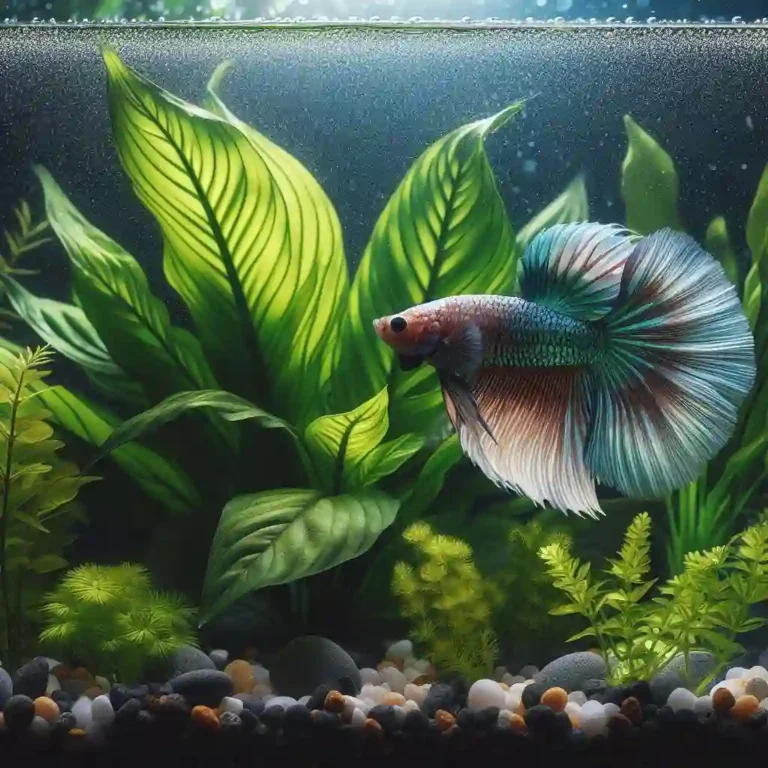Pregnant Platy: Essential Guide to Breeding and Care
The Pregnant Platy is a popular choice among fish enthusiasts for its vibrant colors, peaceful nature, and ease of care.
In this comprehensive guide, we will explore everything you need to know about the breeding process of the Pregnant Platy, from identifying pregnancy to caring for the newborn fry.
Pregnant Platy: A Quick Guide

What to Expect:
- Platies can become pregnant at around 2-3 months of age
- Pregnancy lasts around 24-30 days
- Female platies can store sperm for months, allowing them to fertilize eggs without a male present
Signs of Pregnancy:
- Swollen belly
- Darkening of the abdomen
- Changes in behavior, such as hiding or becoming more aggressive
- Reduced appetite
Caring for a Pregnant Platy:
- Provide a nutritious diet rich in protein and calcium
- Maintain a clean and well-maintained tank with plenty of hiding places
- Avoid stressing the pregnant female, as this can cause her to abort or eat her young
- Consider separating the pregnant female from other fish to reduce stress and aggression
After Birth:
- Female platies can give birth to 20-50 live young
- Babies (fry) are born with a yolk sac that provides nutrition for the first few days
- Provide plenty of hiding places and plants for the fry to hide and grow
- Feed the fry small, frequent meals of infusoria or commercial fry food
Tips and Reminders:
- Platies can breed continuously, so be prepared for multiple pregnancies
- Consider separating the fry from the adults to prevent predation
- Monitor water quality and make regular water changes to ensure a healthy environment for the fry
Identifying a Pregnant Platy: The First Signs
When observing your Platy for signs of pregnancy, a significant and visible enlargement of the abdomen is typically the earliest indication. This swelling results in a more pronounced, rounded belly, giving the fish a somewhat boxy appearance.
Another crucial sign to watch for is the development or darkening of the gravid spot near the anal fin. This spot, which can become more noticeable as the pregnancy advances, serves as a key identifier of a pregnant Platy.
Paying close attention to these physical changes can help aquarists anticipate and prepare for the upcoming birth process, ensuring both the pregnant Platy and her fry receive the care and attention they need for a healthy development.
The Stages of Platy Pregnancy: What to Expect

During the gestation period, which spans approximately 4 to 6 weeks, the Pregnant Platy undergoes several observable changes. Early in the pregnancy, the female’s abdomen starts to expand, and as time progresses, the gravid spot near her anal fin may darken, indicating the pregnancy is advancing.
Behaviorally, the Platy might display signs of seeking solitude, often hiding among aquarium plants or decorations. A notable late-stage sign of pregnancy is when the eyes of the fry become visible through the mother’s transparent abdominal wall.
This visual cue indicates that the birth of the fry is imminent, prompting the need for heightened observation and preparation for the arrival of the new Platy fry. Throughout these stages, maintaining optimal water conditions and nutrition is crucial to support the health of the Pregnant Platy and the development of the fry.
Optimal Tank Conditions for a Pregnant Platy
To support the well-being of a Pregnant Platy and ensure the healthy development of her fry, maintaining the aquarium’s conditions is paramount. The water temperature should be kept within a comfortable range of 72-82 degrees Fahrenheit to mimic their natural habitat and promote optimal health.
It’s also crucial to perform regular water changes and have a reliable filtration system in place to keep the water clean and free of harmful toxins.
Adding ample plants and decorations provides necessary hiding spaces, reducing stress and offering refuge for the pregnant fish. This habitat enrichment not only supports the pregnant Platy’s needs but also creates a safer and more welcoming environment for the fry once they arrive.
Diet and Nutrition: Feeding Your Pregnant Platy

Ensuring the dietary needs of a Pregnant Platy are met is fundamental for the health and development of her fry. Opt for a balanced diet consisting of high-quality flake food designed specifically for livebearers, which will help meet her increased nutritional demands during pregnancy.
To supplement this, offer live or frozen varieties of bloodworms and brine shrimp, which are rich in protein and essential fatty acids, vital for the growth of the fry inside her. It’s important to distribute feedings throughout the day in small, manageable portions.
This strategy helps in avoiding overfeeding, which can deteriorate water quality and adversely affect the health of both the mother and her unborn fry.
Additionally, such feeding practices ensure that the Pregnant Platy consumes a consistent amount of nutrients necessary to sustain both her health and that of her developing offspring.
Preparing Your Aquarium for Newborn Platy Fish
To ready your aquarium for the imminent arrival of Platy fry, it’s essential to create a nurturing and secure environment that mimics their natural conditions for hiding and growth.
Incorporating fine-leaved plants such as java moss or a specially designed breeding box can offer crucial sanctuary spaces for the fry to evade predation by adult tank mates.
Additionally, consider installing a sponge filter or safeguarding the intake of your existing filtration system with a fine mesh to prevent the delicate fry from being inadvertently sucked in.
These adjustments are not only vital for safeguarding the newborns but also encourage a stress-free transition into their new habitat, promoting healthier growth during their initial vulnerable weeks.
Managing Platy Fry Health and Safety
Ensuring the well-being of Platy fry post-birth is critical for their survival and growth. Frequent water changes and strict water quality control are imperative to protect the fry from potential diseases and foster their development.
Early separation of the fry from the adult population is advisable to shield them from predation and competition, safeguarding their food intake and growth trajectory. It’s important to closely observe the fry for any signs of distress or illness, intervening promptly with the appropriate care.
Maintaining an environment that supports their delicate needs during these formative weeks is essential for nurturing a healthy, vibrant new generation of Platy fish.
Introducing Platy Fry to the Tank: A Gradual Process
The successful integration of Platy fry into the main aquarium requires a strategic and cautious approach. Initially, the fry should be housed in a separate nursery tank or breeding box to allow them to grow without the threat of predation from adult fish.
As they develop and become more robust, a gradual introduction to the main tank can commence. This process involves slowly acclimating the fry to the water conditions of the larger aquarium to minimize stress.
During this period, close observation is key to ensure that the fry are not being harassed or outcompeted for food by their adult counterparts. To facilitate a smoother transition, it is advisable to feed the adult Platies in a separate area of the tank, diverting their attention away from the newly introduced fry.
This tactic helps in mitigating potential aggression or food competition, allowing the fry to explore their new surroundings with reduced risk.
The Birth Process: Preparing for Platy Fry
As the time approaches for the Platy to give birth, observing her behavior becomes increasingly important. Signs of impending labor include increased agitation and possible attempts to isolate herself within the tank. Creating an environment that minimizes stress is key during this critical period.
This can be achieved by ensuring the aquarium maintains a low-light setting and by reducing noise and movement around the tank to avoid startling the expectant mother. Additionally, providing plenty of hiding spots with plants and decorations can offer the Pregnant Platy a sense of security and a comfortable place to deliver her fry.
It’s also beneficial to have a breeding box or a separate birthing tank ready, to which the mother can be moved if necessary to protect the fry immediately upon birth. Keeping these considerations in mind will aid in creating a conducive birthing environment, allowing for a smoother delivery process for the Platy and her offspring.
Post-Birth Care: Ensuring the Health of Mother and Fry
After the birthing process, immediate attention to the health of both the mother Platy and her newborn fry is paramount. The mother should be gently relocated to her original tank or a recovery area to prevent any risk of her consuming the fry, a common behavior post-birth. This separation also allows the mother to recuperate in a stress-free environment.
It’s essential to focus on replenishing her strength; feeding her high-quality, nutrient-rich foods at this time is crucial for her recovery. For the fry, ensuring they are in a safe, well-equipped nursery area within the tank is key. The environment should be kept pristine with regular, careful maintenance to prevent disease.
Providing the fry with finely crushed feed, suitable for their tiny mouths, ensures they receive the necessary nutrients for strong growth. Vigilant observation during these early days is critical to identify and address any signs of distress or ill health in both the mother and her offspring promptly, setting the stage for their continued well-being and development.
Breeding Platy Fish: Tips for a Successful Spawn
For those keen on breeding Platy fish, it’s crucial to embark on the journey with a well-thought-out strategy and a commitment to the well-being of both the adult Platies and their fry. Key to a thriving spawning environment is the emphasis on water quality; ensure your aquarium is routinely tested and maintained to keep parameters stable.
A varied and nutritious diet is paramount, especially for the pregnant Platy, to support her through the gestation period and beyond. Creating a stress-free environment for the expecting Platy and her fry involves not just optimal physical conditions but also careful monitoring and adjustments based on their behavior and needs.
A separate breeding area can significantly increase the survival rate of newborn fry by providing a safe haven from potential threats within the main tank. Engaging in regular observation helps in identifying any issues early, allowing for timely intervention.
By focusing on these elements, breeders can enhance the likelihood of a successful and rewarding breeding experience, contributing to the health and vitality of their aquatic family.
FAQs
Q: How long does it take for Platy fry to mature?
A: Platy fry typically take about 4 to 6 months to reach full maturity, although they start showing their colors and sexual differences as early as 1 to 2 months.
Q: Can Platy fish breed with other livebearers?
A: While Platy fish are part of the livebearer family, which includes guppies, mollies, and swordtails, they usually do not crossbreed in home aquariums. It’s best to keep species together to prevent hybridization, which can lead to health and viability issues in offspring.
Q: How often can a Platy become pregnant?
A: A female Platy can become pregnant again shortly after giving birth, often within a month. They have the ability to store sperm, allowing them to give birth multiple times from a single mating.
Q: What should I do if the Platy fry are not eating?
A: If Platy fry appear disinterested in food, try offering micro-sized feeds, such as infusoria or commercially available liquid fry food. Ensuring the water quality is high and stress is minimized also encourages feeding.

Hello, I’m Aria Cooper, the heart and soul behind Swimmy Buddies. As a devoted fish aficionado, I share my aquatic adventures and expertise to inspire your own underwater explorations. 🐠🌊







